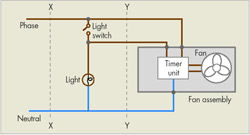Kitchens and bathrooms now are often fitted with extract fans either to meet the requirements of the Building Regulations or at the owner’s request.

Such fans will need to be replaced or repaired during the lifetime of the installation. The IET Helpline often receives enquiries relating to two aspects of these fans; the isolation and switching requirements of BS 7671 and the ventilation requirements of the Building Regulations.
In this article we will explain briefly the concepts of isolation and switching and then discuss these functions in relation to extract fans and in an upcoming article we will cover the ventilation requirements placed by Part F of the Building Regulations.
This highly informative article by John Ware is extracted from IEE Wiring Matters - Spring 2007 issue. Wiring Matters is a quarterly publication from the Institution of Engineering and Technology (IET). To find out how to receive your copy, please contact the IET using the details below.
Isolation and switching
The term isolation and switching, as used in BS 7671: 2001 Requirements for Electrical Installations (The IEE Wiring Regulations) refers to four distinct functions:
- Isolation,
- Switching off for mechanical maintenance,
- Emergency switching, and
- Functional switching.
The concepts of isolation and switching are summarized in Table 1.
Isolation
The definition of isolation, in BS 7671 (The IEE Wiring Regulations) is: ‘A function intended to cut off for reasons of safety the supply from all, or a discrete section, of the installation by separating the installation or section from every source of electrical energy’. Isolation is provided to permit an electricallycompetent person to work safely on all or part of an electrical installation. Once electrical equipment has been securely isolated from the source of energy and any electrical energy has been discharged, a skilled or instructed person should be able to safely access parts that are normally live, or may become live, without the risk of danger from electric shock, electric arcing or explosion or from electrically-powered equipment and machines.
The corresponding definition in the Electricity at Work Regulations (EWR) adds the specific requirement that the isolation is to be secure.
This means the isolated equipment cannot be re-energised accidentally or inadvertently.
The procedure of ‘Isolation’ includes (a) correct identification of the equipment and circuit to be worked on, (b) disconnection, (c) securing the means of disconnection, (d) posting notices and (e) proving dead. In some cases additional precautions will also be needed. Please refer to the HSE publication: Electricity at Work: Safe Working Practices.
Requirements applicable to isolation are given in BS 7671: 2001 Requirements for Electrical Installations and Regulation 12 of the EWR and these requirements are summarized in Table 2.
To read full article please see attachment below...
This article was originally published in IET Wiring Mattars 22 Spring 2007.
